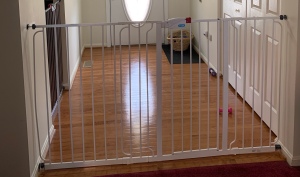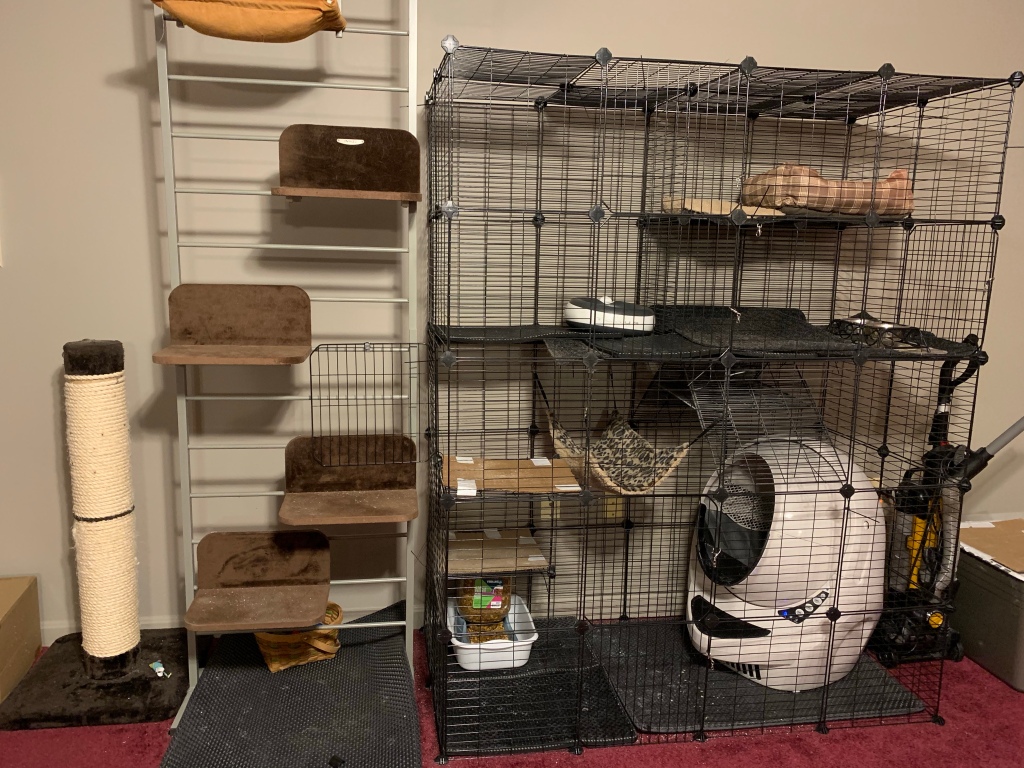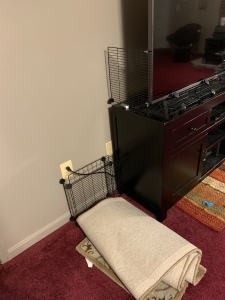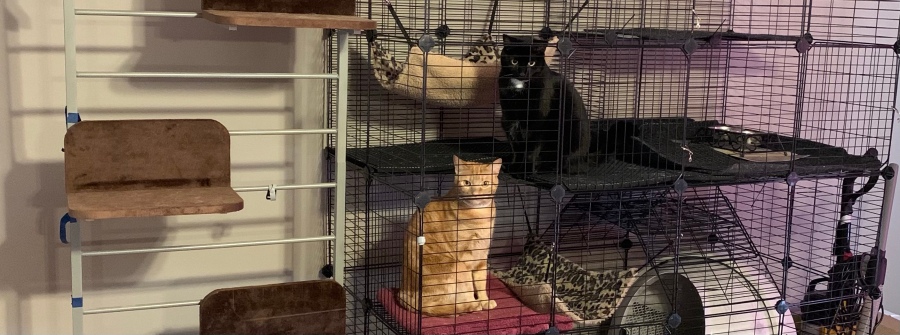How to keep cats from imposing chaos on the entire house? Long story short, we restrict mobility, depending on the situation.
We know many people let their cats roam free all the time, but we really value our ability to sleep through the night (quite literally), knowing that little kitty paws aren’t getting into too much trouble (especially in the kitchen and where we eat). We love them dearly, and wish we could grant more privileges (some things are based on their behavior), but this is where we’re at.
For day-to-day, extra-tall baby gates with vertical bars have worked pretty well for corralling them. The orange kitty jumped over just once, but that was when there was something really interesting on the other side.
You can get extension kits, too. We have extra peace of mind being able to keep the cats from the front door area, so they can’t easily slip out that way. For example, 24” or 12”.

When the kitties need extra confinement (like if contractors are repeatedly coming in and out of the house and leaving doors open), we put them in a custom habitat we built. The panels are connected with node units and zip ties. We used two packs from Amazon. (see also newer model – Amazon).

In the event they do get out, they have breakaway collars with their names and a phone number embroidered. We got ours through Etsy, and have been pleased!
You’ll notice the litter-collecting mats on both levels (ones like this – Amazon). Before they had this setup, they were really tracking litter all over the house. The mats help, for sure, but we think the structure of the habitat also does a lot to keep litter from the living area. To get into and out of the litter area, they have to climb two steps (and two steps on the outside on their vertical kitty climber). On the way out, much of the litter falls off their paws before they reach the living area. The cage wire is uncomfortable on their paws, so use litter mats, cardboard, or towels where they’ll be walking. This vertical-focused setup takes up much less floor space than other arrangements we’ve tried.
And how about no more scooping litter, ever, just handling the collection drawer twice a week or so (for two cats)? We knew getting an automatic system would be a gamble, but the Litter Robot has really been a life-changer! The biggest criticism we have is that the collection drawer could be bigger, especially with waste gathering more at one side than the other (so sometimes when the drawer says it’s full, we just shuffle the collection and it will be another two days or so before it fills up for real). Some folks have done interesting custom modifications, such as a kitty cabana with lots of waste storage space. We’ve found that standard 13-gallon trash bags work well, and much less expensive than the Litter Robot bags.
Edit: The soft litter collecting mat underneath the Litter Robot started to interfere with its cat sensing ability (an irregular foam surface), so we switched to hard flooring underneath, with smaller litter mats where they fit. None right in front because we needed room to pull out the drawer.

We also managed to find a pet water dispenser that works much like a gravity dispenser, but isn’t as prone to failure. But if you’re going to use any sort of gravity water dispenser or fountain, we recommend putting it in a decent-sized under-bed-style plastic bin, so any failure doesn’t damage your floors. (Definitely not still upset about what happened on our hardwood…) A generic gravity feeder has worked fine for dry food.
We’ve also been experimenting with an at-least makeshift cardboard barrier in front of the kitchen, so we can open one of our doors and invite them into another area of the house while we’re there to supervise them. I’d call it a work in progress (and not yet deserving a picture), but it’s a large cardboard panel from something like a TV box, cut to fit over the opening, and secured in place with Command strips (with staples and duct tape keeping them on the cardboard right now).

Despite having all this infrastructure in place, the kitties aren’t always well-behaved. They enjoy loitering on hard flat surfaces like the coffee table and TV stand, and scratching the carpets (even with various types of dedicated cat scratchers within reach). Especially the black kitty – who may have related obsessive-compulsive tendencies. He’s also especially slow on pattern recognition that doesn’t involve food or abundant affection. The orange kitty is just irreverent.
We eventually gave up and dug out an old rolled-up rug just for them to scratch (we thought it was the stiff layer on the bottom that was most satisfying to scratch, so that’s why we kept it inside-out). This was after trying several types of cat scratchers, including a horizontal one. In any case, the extra tall scratcher mentioned above was a great purchase – the orange kitty especially enjoys a nice extended scratch (and in his youth often used to jump up and try to climb outer wall corners). He’ll perch up there like an owl sometimes – it’s adorable.
We also modified the TV area to be less appealing for loitering and playing with cords (using pieces from the habitat set mentioned above). When the TV is on, our orange kitty sometimes gets overly excited and climbs up to swat at moving objects – less so since the modifications, though.
Otherwise, we attempt to address infractions with Discipline Bottles. Nothing fancy, just a spray bottle with tap water, stationed throughout the house for easy reachability. For best results, spray in the face with stream mode. However, both cats, for different reasons, have trouble with pattern recognition, so it’s not entirely effective. We’ve been using bottles from Dollar Tree, but Amazon has something similar.
We don’t let them spend the night with us because they’re badly behaved overnight – climbing all over us, getting onto nightstands, and knocking things over. We now even have a baby gate before the hallway to our bedroom – because before we did that, they would “camp out” outside our bedroom door and trip us on the way out (and maybe even try to slip in!). We do let them come in for occasional visits, though, especially in the morning on weekends!

The one thing that had been especially bad as far as getting knocked over has been our nightstand lamps. Only part of the metal base was actually resting on the nightstand, so along with being a bit top-heavy, they tipped over easily (even in the absence of cats). After the lamps got in rough enough shape, we purchased new ones with flat bases. We’re hopeful that they’ll be more more stable and workable for kitty visits. So far so good!
Taking good care of them is of course essential for their health. But on a more practical note, we find that brushing them regularly (every two weeks or so – they need it more so in the summer) virtually eliminates hairballs (and therefore those messes – but for the inevitable it helps to have a carpet spot cleaner on hand). The Hartz Slicker has worked well for this purpose, though it’s not the kitties’ favorite activity…
One more point! Please, please, please adopt more than one cat or kitten at a time if you can! It keeps them happier having kitty companionship, and I think it keeps them out of some trouble (play-fighting with each other rather than destroying human things out of boredom). Look at these brothers together! Aren’t they precious?

Hope some of this was helpful!


